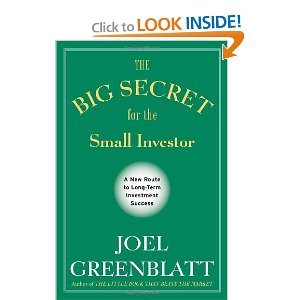Personality. Sarcasm. Normally I don’t use entertaining words to describe personal finance books, but this one embodies those qualities.
In this very brief read by Joel Greenblatt (an investment company owner and professor at the Columbia Business School), Greenblatt colorfully lays out his arguments and foundation for his two part (A and B) investment plan which he refers to as his “Big Secret”.
Summary of Part A to Greenblatt’s “Big Secret”:
• A “Market Capital Weighted Index (MCWI)” (Company’s Market Capital / The Sum of all the Market Capital in the Index = The Company’s Weight Percentage within the Index) fund will always outperform those funds ran by Active Managers
The logic here is that Active Managers cannot predict the future of stocks any better than the rest of us, and will likely not outperform an MCWI fund (or any passive index fund). If you accept that over time both funds will return about the same capital returns, then consider that Active Managers charge more fees than passive funds. These fees will erode your gains and therefore yield less return to us, the investors.
• An “Equally Weighted Index Fund” (1 / Number of Companies in the Index = Percentage within the Index) or “Fundamentally Weighted Index Fund” (Company’s Last Year Earnings / Sum of all the Earnings in the Index = Percentage within the Index) will always outperform a “Market Capital Weighted Index” fund.
This again has to with not being able to predict the future. If you base a company’s weight within a portfolio on something more concrete such as previous earnings, then you have a much more reliable foundation for making predictions about future performance.
• A “Value Weighted Index Fund” (Ratio of Last Year’s Earnings to the working capital and fixed assets on the Company’s balance sheet) will always outperform an “Equally Weighted Index Fund” or “Fundamentally Weighted Index Fund”.
The reasoning here is that the market tends to overprice or under-price stocks based on a number of factors. Therefore, the best thing small investors can do is to take advantage of under-valued stocks. This notion is also supported by Benjamin Graham (the mentor of Warren Buffet, currently the most famous investor in the world) who advocated to “buy well below fair value”. Incidentally, this ratio is also referred to as “Return on Assets (ROA)”. In general, the bigger the ratio, the better (in other words, the company is efficient and has the ability to make more money with less assets).
Summary of Part B to Greenblatt’s “Big Secret”:
Part B of the “Big Secret” is not revealed until the last chapter and is basically left to the individual reader’s personal preference. Greenblatt references the concept of “Behavior Finance” which essentially states that humans are too reactive to market ups and downs, and our impulses make us lousy investors. Therefore, his suggestion is to:
• Pick a certain percentage of stocks for your portfolio and stick to it (p. 139).
Together, Parts A and B Reveal:
The “Big Secret” = Small investors can beat professional investors if they follow Plans A and B (p. 140).
My Thoughts:
Although I enjoyed this book and agreed with many of his points, I have yet to do my own research and test Greenblatt’s theory (Part A). He does provide evidence that this strategy will work when analyzing it with S&P data from the last few decades. The notion that active managers cannot beat indexes has been argued and reinforced many times in other financial books.
Similarly, Greenblatt’s Part B has also been suggested in publications before. However, I found it to be somewhat low in emphasis for the context of this book. An individual’s preference for stock-to-bond ratio usually involves many other factors (beyond what was covered) such as age, goals, strategies, preference for risk, etc.
A list of ETF’s and mutual funds (both value and value-weighted) is provided in the Appendix. I was delighted that one of my current investments, Vanguard’s Midcap Value Index (VOE) was among the list! Others include the Rydex ETF (RSP), Powershares ETF (PRF), Vanguard Value ETF (VTV), Vanguard Smallcap Value ETF (VBR), and many others.
If you are just starting out at picking stocks, then this may be good book for learning some new techniques. Also, given the entertainment value and his use of specific examples, it wouldn’t hurt to spend an afternoon giving it a read. (Seriously, you can finish it in about two hours!)




Leave a Reply